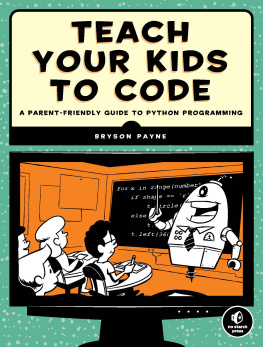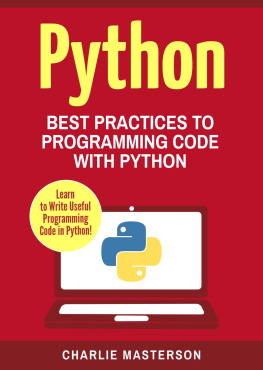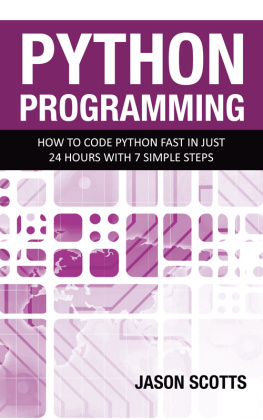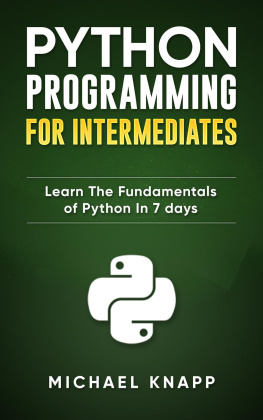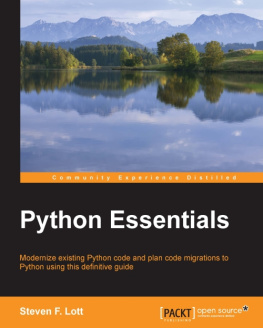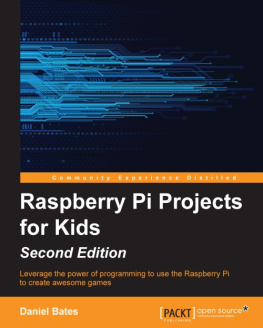M K - Kids can code, Elders also can: Create a simple game using Python
Here you can read online M K - Kids can code, Elders also can: Create a simple game using Python full text of the book (entire story) in english for free. Download pdf and epub, get meaning, cover and reviews about this ebook. year: 2021, publisher: UNKNOWN, genre: Home and family. Description of the work, (preface) as well as reviews are available. Best literature library LitArk.com created for fans of good reading and offers a wide selection of genres:
Romance novel
Science fiction
Adventure
Detective
Science
History
Home and family
Prose
Art
Politics
Computer
Non-fiction
Religion
Business
Children
Humor
Choose a favorite category and find really read worthwhile books. Enjoy immersion in the world of imagination, feel the emotions of the characters or learn something new for yourself, make an fascinating discovery.

- Book:Kids can code, Elders also can: Create a simple game using Python
- Author:
- Publisher:UNKNOWN
- Genre:
- Year:2021
- Rating:3 / 5
- Favourites:Add to favourites
- Your mark:
- 60
- 1
- 2
- 3
- 4
- 5
Kids can code, Elders also can: Create a simple game using Python: summary, description and annotation
We offer to read an annotation, description, summary or preface (depends on what the author of the book "Kids can code, Elders also can: Create a simple game using Python" wrote himself). If you haven't found the necessary information about the book — write in the comments, we will try to find it.
M K: author's other books
Who wrote Kids can code, Elders also can: Create a simple game using Python? Find out the surname, the name of the author of the book and a list of all author's works by series.
Kids can code, Elders also can: Create a simple game using Python — read online for free the complete book (whole text) full work
Below is the text of the book, divided by pages. System saving the place of the last page read, allows you to conveniently read the book "Kids can code, Elders also can: Create a simple game using Python" online for free, without having to search again every time where you left off. Put a bookmark, and you can go to the page where you finished reading at any time.
Font size:
Interval:
Bookmark:
Random number generation ........................................................................................................11
Premarajan
Two players choose and mark the cells by turn.
Whoever completes a continuous row, column or diagonal first, wins.
A player cannot select a cell which has already been marked.
If all cells get marked without either of the player not winning, the game is a Tie.
Let us consider a game played against the computer. Let us assign X to the computer and O to the player for marking their choices.
Display the game rules
Display the board
Choose one player and open the game
Select the cell and mark it
Test if the selection is valid
Test if the input is valid
Test if the cell is already taken
Ending of the game
O wins
Tie
Option to start a new game or to exit


Then the function play_game() is introduced. There, we have added the code for printing the local time and called the function beg_game() . We have also called the function display_board() .However at this stage, there is nothing to be displayed. We have also called the built-in function input() in the last line so that the screen waits for the input before exiting the program. Once we press enter, the program will be exited. Finally, we call the function play_game() .

It takes seconds elapsed as the argument and converts it to date and time. Please see the screen shot below for example:
Countdown

 You call this function from within the my_turn() function. The following game board will be exhibited.
You call this function from within the my_turn() function. The following game board will be exhibited.
The code above completes the third function my_turn() . Please have a look at the last function play_game() shown in the game structure at the beginning. Call the function my_turn() after beg_game() . play_game() will now look as follows:
print(time.ctime())
beg_game()
my_turn()
input()

Font size:
Interval:
Bookmark:
Similar books «Kids can code, Elders also can: Create a simple game using Python»
Look at similar books to Kids can code, Elders also can: Create a simple game using Python. We have selected literature similar in name and meaning in the hope of providing readers with more options to find new, interesting, not yet read works.
Discussion, reviews of the book Kids can code, Elders also can: Create a simple game using Python and just readers' own opinions. Leave your comments, write what you think about the work, its meaning or the main characters. Specify what exactly you liked and what you didn't like, and why you think so.

